Many people’s first introduction to the idea of a black-maned lion was in the Disney classic, The Lion King.
In this movie, Scar acts as the power-hungry villain in a proud pride of lions. His dark mane and his scary character raise some questions about this uniquely-maned feline.
Such as, are darker-haired lions more aggressive than their lighter-maned family? Do black-maned lions have any competitive advantage?
This post will outline some interesting facts about black-maned lions. These facts include why some lions have dark manes and whether or not completely-black lions exist.
Why Do Some Lions Have Black Manes?

A male lion’s mane is a strong indicator of his health. In this way, the mane speaks to the lion’s vigor and strength as well as his testosterone levels.
In short, the darker a lion’s mane, the more powerful he is. A lighter mane means the opposite; that the lion is weaker and has less impressive fighting abilities.
Lions with Black Manes: A Competitive Edge?
In the Lion King, Simba proved to be stronger than Scar. In reality, it seems the result would have been different.
The truth is that black mane lions do have a competitive edge over their lighter-maned counterparts. There are two fascinating reasons for this.
A black mane is a symbol of strength
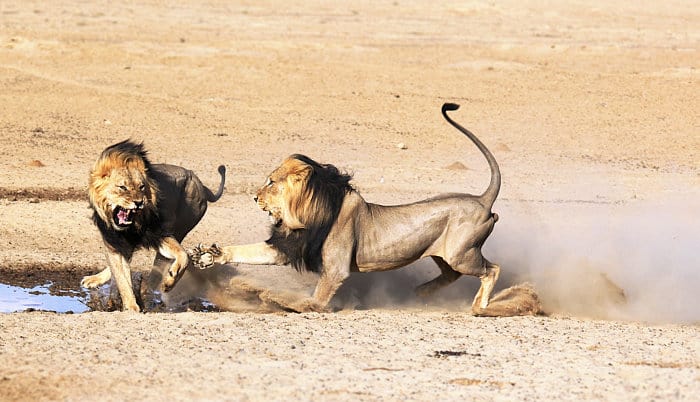
As mentioned, the mane shows how healthy a lion is. Generally, the darker the mane, the stronger the lion is.
A large, dark mane helps in a fight against another lion. It adds an intimidation factor as it makes the lion look naturally larger. A darker mane seems more threatening.
A thick, black mane also shows the lion has a good diet. This suggests the lion is well-nourished and is in its prime, giving it an edge in any conflict.
Because of their health and strength, black-maned males have a longer lifespan than light-maned lions. They also have a better chance of recovering from injuries.
Baby lions sired by darker-maned lions also have a higher survival rate.
The casanova of the lion species
Similar to humans, it seems like female lions also like their males dark and handsome.
Yes, that’s right. Black-maned lions have a reputation with the ladies. Lionesses prefer males with dark manes.
The higher levels of testosterone in males with black manes make them more aggressive than blonde-maned lions. So, nature has definitely given them an advantage in the mating game.
You might think that mane length would be an important factor in attracting a female. The bigger the better, right? Yet, it appears color is more an important factor in their decisions.
Outside elements, like climate and temperature, can affect mane length. This is most likely why the length is a less reliable indicator of the ‘worthiness’ of a lion as a potential mate.
Black Mane Lions Turn Up the Heat
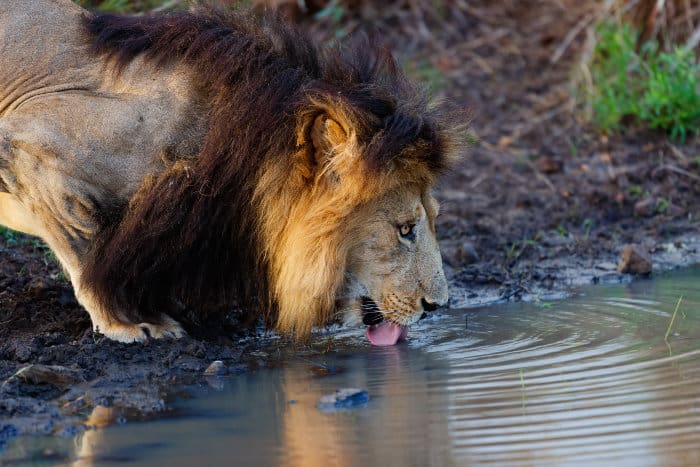
Ladies may consider black manes to be hot, but these dark manes also turn up the heat in a less positive way.
People who live in hot countries learn quite quickly that black clothing absorbs heat. While light-colored clothing helps to keep them cool.
The same applies to lions’ manes. A thick, black mane can be incredibly hot and heavy.
Imagine how uncomfortable it would be to wear a thick, black, woolly scarf around your neck and face in the scorching sun.
A large, dark mane can affect how these lions hunt and live. Some lions will eat less as a result, and only hunt in the night when it’s cool. In fact, wild lions spend a lot of time doing what they can to reduce heat.
Lions don’t sweat the way people do. Their only real coping mechanism for the sun is finding shade and panting.
This includes lying on their backs to expose the thin skin on their bellies to the air. They also enjoy resting on raised areas, which allows them to catch a breeze.
Male lions that live in (somewhat) cooler temperatures, like South Africa, can grow bigger, darker manes.
As temperatures rise, the sun is becoming harsher. This could mean that black manes may fade away as a result of the heat.
Evidence already shows that lion manes are becoming thinner overall. Scientists are of the opinion that this is due to heat too.
Lions that are in captivity in the northern hemisphere often have thicker manes than those in the wild.
When Do Lions Get Their Manes?
Male lions begin to grow their manes when they reach two years old. It indicates that they are becoming sexually mature.
This rite of passage may sound like something to celebrate, but it has its downsides. When a male lion starts to grow a mane, it acts as a signal to the pride to kick him out.
The reason? So that the male leader of the pride maintains his dominance.
Can Lions’ Manes Change Color?

Yes. As discussed previously, a lion’s mane symbolizes his health. This means that the mane color can change when a lion’s health shifts.
You can compare the mane of a lion to a human‘s fingernails or hair. When a person is suffering from a deficiency or stress, the hair and nails may become brittle and weak.
A lion’s mane will lighten if he is sick or going through a rocky health patch. The reverse is also true; when the lion recovers and becomes healthy, the mane will darken.
Ethiopian Lions: The Poster Children of Black Manes
Dark manes are status symbols for strong and healthy lions, so that means a pitch-black mane must be the real deal.
The Ethiopian lion is famous for its extraordinary black mane. Up until 2016, most people thought these cats were extinct.
In that year, researchers discovered a population of 50 of these lions in Ethiopia and 100 or so across the border in Sudan.
A great finding!
The Kalahari is another region known for its rare black-maned beauties. The Kalahari Desert is an expansive sandy savannah that stretches into Botswana, South Africa, and Namibia.
People remember Kalahari lions because of their size and majestic black manes. The jet-black manes contrast against their tawny coloring in a striking fashion that leaves a lasting impression.
Do Black Lions Exist?
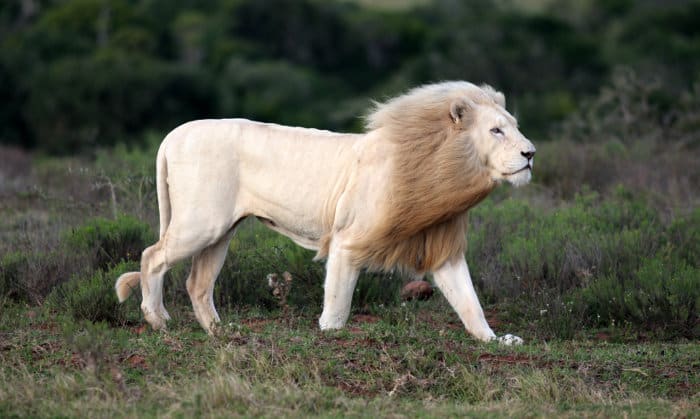
No. Black-maned lions are real, however, completely-black lions do not exist.
In 2012, pictures made the rounds that showed black-haired lions. These pictures were hoaxes. The lions in these photos were digitally manipulated and colored in. No one has discovered a black lion.
Interestingly enough, the opposite does exist. White lions are a thing. They have a rare color mutation that gives them their pale fur.
These light cats are not albinos. A recessive trait causes the unusual coloring in these lions. The trait comes from a less-critical mutation in a gene that brings about albinism.
Strangely, this mutation does not impact these lighter-than-light lions. It does not affect their ability to survive. White lions successfully hunt and live in the wild on their own.
This post answered the question of “are there black lions” with a no. Yet, there is a curious exception to this rule. There is in fact a real black lion animal, just not the one you would expect.
Similar to a normal lion, the black lion tamarin has a gorgeous mane of dark hair. However, this creature isn’t really a king of the beasts.
The black lion tamarin is actually a primate. It’s an incredibly rare monkey that lives in the Brazilian state of São Paulo.
So, if you’re looking for some real lions with black hair, that’s the closest you are going to get.
It’s also a fun fact to share with your friends if you ever hear them ask, “is the black lion real?”
Melanistic lions: a possible reality
Humans have not found black lions…yet. However, there is a possibility that they could appear in the future.
Have you heard of a black panther and black jaguar? Well, these are cats that carry a rare congenital condition called melanism.
Melanism refers to an unusually high increase in the amount of dark pigment or melanin present in an animal. It is the opposite of albinism.
Albinism involves an abnormal decrease in the melanin levels of an animal, which leads to a lack of pigment.
So, even though no one has spotted a black-haired lion; this doesn’t mean it couldn’t happen. In theory, an all-black lion could come into existence.
Black-Maned Lions – A Worthy Reputation

Black manes are definitely a status symbol among the kings of the jungle.
A lush, dark mane means a lion in his prime, eating like a champ, and receiving a lot of attention from the ladies. They are not shady outcasts, banished to the badlands.
So, the next time you’re in the wild on a safari and you see a lion with a particularly dark mane, tip your cap to him. Pay your respects to the king of the kings.
If you’d like to experience the wonders of wild Africa for yourself, plan your ultimate safari trip with the Africa Freak experiential safari service!
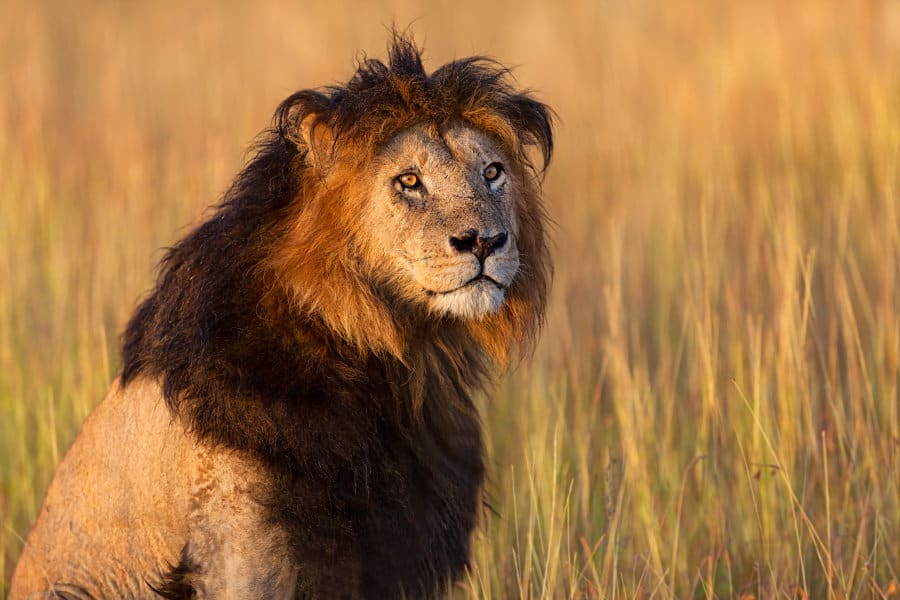
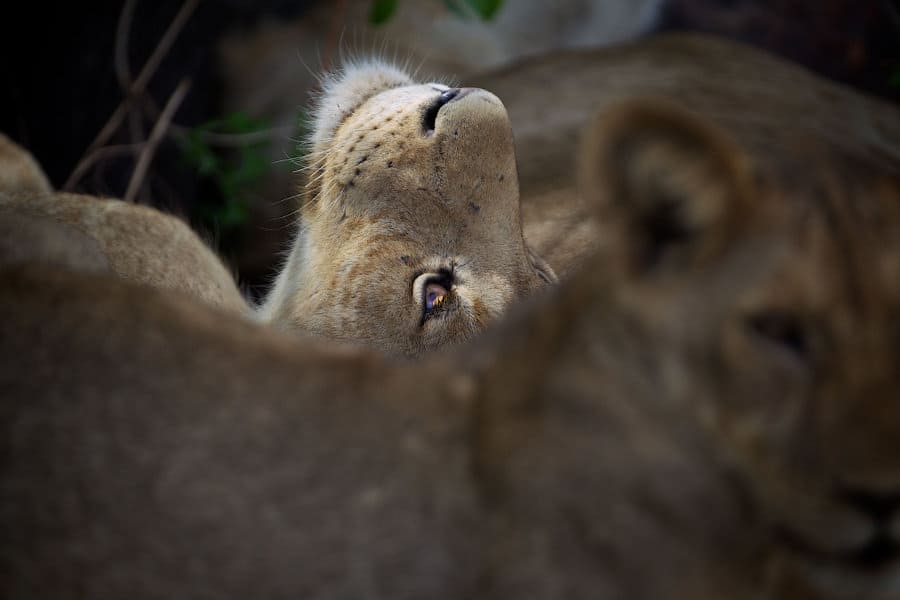
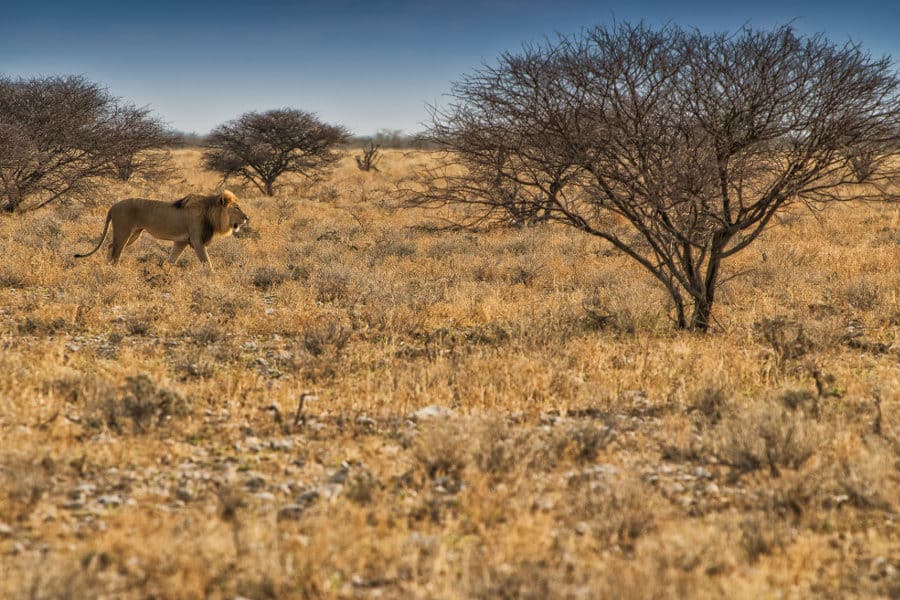

A website like yours should be better informed. “King of the jungle” you call the lion. How many lions do you know that live in the jungle?
Fact is that lions live in the savanna. Please correct the mistake.
Hi Ursula,
Thanks for your constructive comment.
We’ve discussed this in length, though we sometimes still use the popular expression. 🙂
Here’s more details on the matter:
– African jungle: 10 misconceptions about animals, plants, & more (cf point “4.”)
– Top 10 common misconceptions about Africa – Stereotypes & myths
Indeed, lions could definitely claim the title “king of the savannah”. 😉
Cheers,
Michael
The article did cover where the lions are from and their general environment; it is informitive and well written if one takes the time to fully read the article. I believe the expression “king of the jungle” is similar to how many say “tinfoil” or “tin can”. they have been made from aluminum for much longer, the name just stuck. Us readers do know that lions live on the Savannah, all is well.
I remember seeing black maned lions in a lion park at Southport outside Brisbane (around 1970), in a separate enclosure. I thought they were labeled Abyssinian (correct my spelling), but memory on that may be faulty. Mane colour seemed to be the only difference from others but seemed to be a large enough group.
Hi Jim,
Thanks for your comment.
Abyssinian lions are endemic to Ethiopia, and males do indeed have beautiful black manes. This subspecies is slightly smaller than its East African cousin.
From what I know their population has dwindled in recent years, though you may still encounter them in places like Bale Mountains National Park or Alatash National Park.
All the best,
Michael